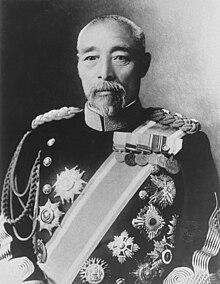| Oku Yasukata | |
|---|---|
| 奥 保鞏 | |
 Japanese General Count Oku Yasukata Japanese General Count Oku Yasukata | |
| Chief of the Imperial Japanese Army General Staff Office | |
| In office July 30, 1906 – January 20, 1912 | |
| Monarch | Meiji |
| Preceded by | Kodama Gentarō |
| Succeeded by | Hasegawa Yoshimichi |
| Personal details | |
| Born | (1847-01-05)5 January 1847 Kokura, Buzen Province, Japan |
| Died | 19 July 1930(1930-07-19) (aged 83) Tokyo, Japan |
| Awards | Order of the Golden Kite (1st class) |
| Military service | |
| Allegiance | |
| Branch/service | |
| Years of service | 1871–1911 |
| Rank | Field Marshal |
| Commands | IJA 5th Division, IJA 1st Army, Imperial Guard of Japan, IJA 2nd Army |
| Battles/wars | |
Count Oku Yasukata (奥 保鞏, 5 January 1847 – 19 July 1930) was a Japanese field marshal and leading figure in the early Imperial Japanese Army.
Biography
Early life
Born in Kokura (in present-day Kitakyūshū) to a samurai family of the Kokura Domain in Buzen Province, Oku joined the military forces of the nearby Chōshū Domain during the First and Second Chōshū expeditions and the Boshin War in their struggle to overthrow the Tokugawa shogunate and bring about the Meiji Restoration.
Military career
Appointed a commander of the new Imperial Japanese Army, Oku fought against the disgruntled samurai insurgents during the Saga Rebellion of 1871. He was later a survivor of the Taiwan Expedition of 1874. During the Satsuma Rebellion, he defended Kumamoto Castle during its siege as commander of the 13th Infantry Regiment.
During the First Sino-Japanese War Oku succeeded General Nozu Michitsura commander of the IJA Fifth Division of the IJA First Army. Later, he successively held posts as commander of the Imperial Guards and Governor-general for the defense of Tokyo. He was elevated to the title of danshaku (baron) under the kazoku peerage system in 1895, and was promoted to army general in 1903.
During the Russo-Japanese War, Oku went to the front as commanding general of the IJA 2nd Army and was noted for his role in the Battle of Nanshan, Battle of Shaho, Battle of Mukden, and other campaigns.
Oku was awarded the Order of the Golden Kite (1st class) in 1906, and elevated from baron to hakushaku (count) in 1907. In 1911, he received the largely honorary rank of Field Marshal.
Oku refused to attend strategy and staff meetings, and thereby gained a reputation for being both a "lone wolf" and also a brilliant tactician capable of independent action. However, Oku's reluctance to attend the staff meetings was due to his partial deafness, and inability to comprehend and contribute to the discussions.
Post-war life
Oku had absolutely no interest in politics, and lived in virtual seclusion after the war. When he died of an Intracranial hemorrhage in 1930, many people were astonished, thinking that he had died years previously.
Decorations
- 1878 –
 Order of the Rising Sun, 4th class
Order of the Rising Sun, 4th class - 1885 –
 Order of the Rising Sun, 3rd class
Order of the Rising Sun, 3rd class - 1893 –
 Order of the Sacred Treasure, 2nd class
Order of the Sacred Treasure, 2nd class - 1895 –
 Order of the Rising Sun, 2nd class
Order of the Rising Sun, 2nd class - 1895 –
 Order of the Golden Kite, 3rd class
Order of the Golden Kite, 3rd class - 1900 –
 Grand Cordon of the Order of the Sacred Treasure
Grand Cordon of the Order of the Sacred Treasure - 1905 –
 Grand Cordon of the Order of the Rising Sun
Grand Cordon of the Order of the Rising Sun - 1906 –
 Order of the Golden Kite, 1st class
Order of the Golden Kite, 1st class - 1906 –
 Order of the Rising Sun with Paulownia Flowers
Order of the Rising Sun with Paulownia Flowers - 1928 –
 Order of the Chrysanthemum
Order of the Chrysanthemum
References
- Craig, Albert M. Chōshū in the Meiji Restoration. Cambridge: Harvard University Press, 1961.
- Dupuy, Trevor N. (1992). Encyclopedia of Military Biography. I B Tauris & Co Ltd. ISBN 1-85043-569-3.
- Harries, Meirion (1994). Soldiers of the Sun: The Rise and Fall of the Imperial Japanese Army. Random House. ISBN 0-679-75303-6.
- Keane, Donald (2005). Emperor Of Japan: Meiji And His World, 1852–1912. Columbia University Press. ISBN 0-231-12341-8.
- Paine, S.C.M. (2003). Sino-Japanese War of 1894–1895: Perception, Power, and Primacy. Cambridge University Press.
- Jukes, Geoffry (2002). The Russo-Japanese War 1904–1905. Osprey Essential Histories. ISBN 978-1-84176-446-7.
External links
- National Diet Library. "Oku Yasukata". Portraits of Modern Historical Figures.
Notes
- Craig, Choshu in the Meiji Restoration
- National Diet Library, Portraits of Modern Historical Figures
- Jukes, The Russo-Japanese War
- Dupuy, Encyclopedia of Military Biography
- ^ Japanese[REDACTED] article
- 『官報』第562号「叙任及辞令」May 19, 1885
- 『官報』第2971号「叙任及辞令」May 27, 1893
- ^ 『官報』第3644号「叙任及辞令」October 21, 1895
- 『官報』第5072号「叙任及辞令」June 1, 1900
- 『官報』第6573号「叙任及辞令」May 31, 1905
- ^ 『官報』号外「叙任及辞令」December 30, 1906
- 『官報』号外「叙任及辞令」November 10, 1928
- Marshals of Japan
- 1847 births
- 1930 deaths
- People from Kitakyushu
- People of the Boshin War
- Kazoku
- Japanese military personnel of the First Sino-Japanese War
- Japanese military personnel of the Russo-Japanese War
- People of Meiji-era Japan
- Recipients of the Order of the Rising Sun with Paulownia Flowers
- Grand Cordons of the Order of the Rising Sun
- Recipients of the Order of the Sacred Treasure, 1st class
- Recipients of the Order of the Golden Kite, 1st class
- Grand Officers of the Legion of Honour
- Recipients of the Virtuti Militari
- Recipients of the Military Merit Order (Bavaria)